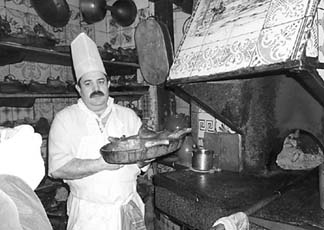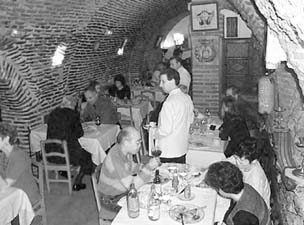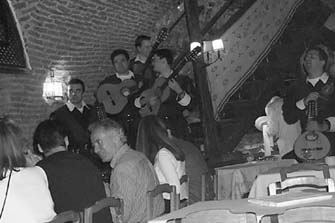![[MetroActive Dining]](/gifs/dining468.gif)
[ Dining Index | Sonoma County | MetroActive Central | Archives ]
Old World Charm
This little piggie ...: Chef Juan Maneiro of Casa Botín serves up a suckling pig slow-roasted in the restaurant's 18th-century woodstove.
A glimpse of Casa Botín: 'World's oldest restaurant'
By Paula Harris
WE'RE SPRAWLED in a small hostel room in the center of Madrid, listening to a rhythmic rumba gitana pulsating from the boom box we hauled over along with suitcases crammed with hip-hugging ruffled skirts and nail-embedded dance shoes.
It's been an arduous journey, but we won't unpack. This is a stopover. Tomorrow morning my friend Helen and I will catch the high-speed AVE train to Seville, where we'll study flamenco dance. If we can revive in time.
It's dark outside. We slowly crank open the balcony shutters in the modest pension room near central Puerta Del Sol and peer out into the sultry night.
Nocturnal Madrid glitters and swirls below.
Calle Marqués Viudo de Pon-tejos--a bustling street filled at 10:30 p.m. with honking traffic, unleashed dogs, and strolling pedestrians--beckons enticingly. We ignore the jet lag that prickles behind our eyes and join the evening throng.
Outside, the warm night air reeks of exhaust fumes, lemon cologne, black tobacco, and frying garlic. It's intoxicating. We head to Plaza Mayor, the large colonaded cobblestone square in the old part of the city, filled with taverns and handicraft workshops. Our destination is Casa Botín, once a favorite haunt of Ernest Hemingway's.
"We lunched upstairs at Botín's. It is one of the best restaurants in the world. We had roast young suckling pig and drank rioja alta," the author wrote of Jake and Brett's visit to the venerable landmark, on the second to last page of The Sun Also Rises.
If Hemingway made the restaurant famous, the Guinness Book of Records further cemented its celebrity last year by proclaiming Casa Botín (founded in 1725) the World's Oldest Restaurant.
Stepping back in time: The brick-lined dining room is steeped in history.
CASA BOTÍN is located on Calle de Cuchilleros (Cutler's Street) in the heart of Madrid's old commercial center. We pass through an ancient archway and descend stone steps that are illuminated by an old wrought-iron lantern protrouding from a crumbling wall.
The restaurant was once a small inn where weary muleteers and traders ended their journeys with a sumptuous roast dinner and a bed for the night.
Our first impression when we enter the four-story building with its four distinct dining rooms is of exposed beams, oil paintings, hanging copper pans, and crimson carnations against snowy table linens.
It's like stepping back in time.
At the heart of it all is an open kitchen boasting the original 18th-century woodfire oven, fueled by aromatic green oak logs. It's still used to cook the house specialties: traditional Castillian roast lamb and whole suckling pig.
Chef Juan Maneiro, a burly figure in a white toque, tends the flames. The heat burns slowly and constantly builds up layers of flavor. One roast takes 2 1/2 hours, Maneiro tells us, as he removes a shallow earthenware casserole of fragrant pork.
Casa Botín caters to a bustling mixed clientele. The Madrileños are well dressed and poised with their Fortuna cigarettes and sleek leather accessories. The tourists tend to wear thick-soled sneakers and fret about what to order.
Our table is downstairs in a cavernous brick dining room set deep underground and steeped in history. Here also is a an ancient wine cellar resembling a catacomb, where dust-encrusted bottles of rioja are taking an extended siesta.
We eat creamy triangles of tangy queso manchego, sheep's cheese from La Mancha, with crusty fresh bread and a glass of chilled extra-dry fino sherry. The fino is so pale and ethereal, it's been dubbed "the wine with a hundred souls."
We could have dined on baby eels or stewed partridge, but how could we pass up the roasted suckling pig with its crispy bronzed skin and luscious meat? It's a huge portion--actually enough for two. The slow cooking has rendered the meat sweet and tender and infused with olive oil, herbs, and garlic. Add some perfectly golden roast potatoes and a noble valdepeñas house red wine to wash it all down and we're in hog heaven.
For dessert, we savor slices of cool fresh pineapple marinated in Dry Sack sherry, and smooth housemade caramel custards with whipped cream. The meal is capped with strong coffee and a small glass of pacharán, a sweet anise-flavored elixir made from sloes.
AT MIDNIGHT, a group of student minstrels, in black cloaks trimmed with colorful ribbons, serenades diners with old regional songs strummed on lute-type instruments. We watch as if in a dream while waiters in their white jackets flutter among the tables like graceful moths.
Antonio González, a gracious man with a courtly manner, tells us his family has owned Casa Botín for three generations. Another family member opened a Casa Botín in Miami last year. One of the partners of the Miami restaurant is from San Francisco, so a future Casa Botín may be slated for the Bay Area, says González.
What's the recipe for Casa Botín's impressive longevity? "Of course, the food must be the best we can offer, but there's something about warm cordiality, even from the youngest waiter, so that you feel a little like you're in your own home," explains González.
"It's not only the taste of the pig, but that you feel fine," he says with a faraway look in his dark eyes. "Taste alone is not enough to remember--a restaurant is not only a place to have food and drink, it's a place to collect moments in life."
Hemingway would have agreed.
[ Sonoma County | MetroActive Central | Archives ]
Copyright © Metro Publishing Inc. Maintained by Boulevards New Media.
![]()

Helen Hintereder

Helen Hintereder

Helen Hintereder
From the July 15-21, 1999 issue of the Sonoma County Independent.